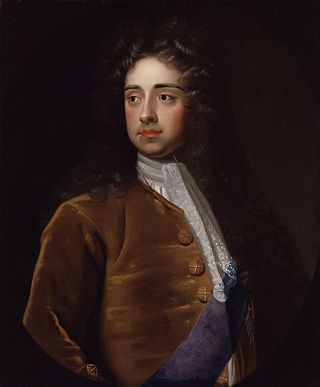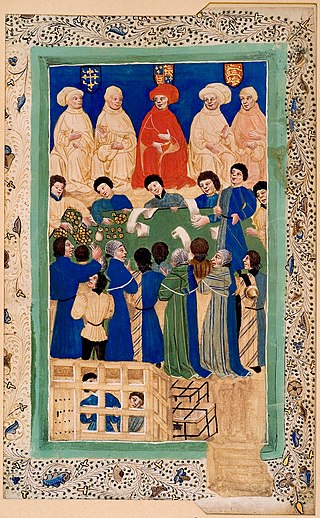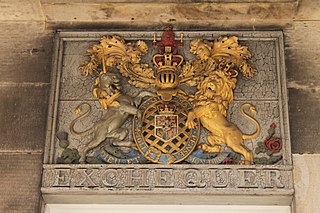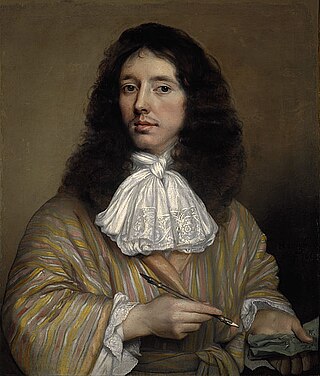Related Research Articles

The Lord High Treasurer was an English government position and has been a British government position since the Acts of Union of 1707. A holder of the post would be the third-highest-ranked Great Officer of State in England, below the Lord High Steward and the Lord High Chancellor of Great Britain.
Baron Bruntisfield, of Boroughmuir in the City of Edinburgh, is a title in the Peerage of the United Kingdom. It was created in 1942 for the Scottish Conservative politician and former Vice-Chamberlain of the Household, Sir Victor Warrender, 8th Baronet. The Warrender family descends from George Warrender. He was Lord Provost of Edinburgh and represented Edinburgh in Parliament. In 1715 he was created a baronet, of Lochend in the County of Haddington, in the Baronetage of Great Britain. His grandson, the third Baronet, fought at the Battle of Minden in 1759, represented Haddington Burghs in the House of Commons and served as King's Remembrancer of the Court of Exchequer from 1771 to 1791. He was succeeded by his son, the fourth Baronet. He sat as a Member of Parliament for Haddington Burghs, Truro, Sandwich, Westbury and Honiton and notably served as a Lord of the Admiralty from 1812 to 1812. In 1822 Warrender was admitted to the Privy Council. On his death the title passed to his younger brother, the fifth Baronet. His grandson, the seventh Baronet, was a Vice Admiral in the Royal Navy. He was succeeded by his son, the eighth Baronet, who was raised to the peerage as Baron Bruntisfield, of Boroughmuir in the City of Edinburgh, in 1942. As of 2010 the titles are held by the latter's grandson, the third Baron, who succeeded in 2007. He is a retired officer in the British Army and investment banker.

His Majesty's Advocate, known as the Lord Advocate, is the principal legal adviser of both the Scottish Government and the Crown in Scotland for civil and criminal matters that fall within the devolved powers of the Scottish Parliament. The Lord Advocate provides legal advice to the government on its responsibilities, policies, legislation and advising on the legal implications of any proposals brought forward by the government. The Lord Advocate is responsible for all legal advice which is given to the Scottish Government.

His Majesty's Solicitor General for Scotland is one of the Law Officers of the Crown, and the deputy of the Lord Advocate, whose duty is to advise the Scottish Government on Scots Law. They are also responsible for the Crown Office and Procurator Fiscal Service which together constitute the Criminal Prosecution Service in Scotland.

The Exchequer of Pleas, or Court of Exchequer, was a court that dealt with matters of equity, a set of legal principles based on natural law and common law in England and Wales. Originally part of the curia regis, or King's Council, the Exchequer of Pleas split from the curia in the 1190s to sit as an independent central court. The Court of Chancery's reputation for tardiness and expense resulted in much of its business transferring to the Exchequer. The Exchequer and Chancery, with similar jurisdictions, drew closer together over the years until an argument was made during the 19th century that having two seemingly identical courts was unnecessary. As a result, the Exchequer lost its equity jurisdiction. With the Judicature Acts, the Exchequer was formally dissolved as a judicial body by an Order in Council on 16 December 1880.

The Crown Office and Procurator Fiscal Service is the independent public prosecution service for Scotland, and is a Ministerial Department of the Scottish Government. The department is headed by His Majesty's Lord Advocate, who under the Scottish legal system is responsible for prosecution, along with the sheriffdom procurators fiscal. In Scotland, virtually all prosecution of criminal offences is undertaken by the Crown. Private prosecutions are extremely rare.

The office of Lord Clerk Register is the oldest remaining Great Officer of State in Scotland, with origins in the 13th century. It historically had important functions in relation to the maintenance and care of the public records of Scotland. Today these duties are administered by the Keeper of the National Records of Scotland and the Keeper of the Registers of Scotland.

The Bearer of the Royal Banner is one of the Great Officers of the Royal Household in Scotland. The bearer participates in royal, state, and other ceremonial events when needed.
The Treasurer was a senior post in the pre-Union government of Scotland, the Privy Council of Scotland.
Unowned property includes tangible, physical things that are capable of being reduced to being property owned by a person but are not owned by anyone. Bona vacantia is a legal concept associated with the unowned property, which exists in various jurisdictions, with a consequently varying application, but with origins mostly in English law.

A procurator fiscal, sometimes called PF or fiscal, is a public prosecutor in Scotland, who has the power to impose fiscal fines. They investigate all sudden and suspicious deaths in Scotland, conduct fatal accident inquiries and handle criminal complaints against the police. They also receive reports from specialist reporting agencies such as His Majesty's Revenue and Customs.
The Remembrancer was originally a subordinate officer of the English Exchequer. The office is of great antiquity, the holder having been termed remembrancer, memorator, rememorator, registrar, keeper of the register, despatcher of business. The Remembrancer compiled memorandum rolls and thus “reminded” the barons of the Exchequer of business pending.
The King's Remembrancer is an ancient judicial post in the legal system of England and Wales. Since the Lord Chancellor no longer sits as a judge, the Remembrancer is the oldest judicial position in continual existence. The post was created in 1154 by King Henry II as the chief official in the Exchequer Court, whose purpose was "to put the Lord Treasurer and the Barons of Court in remembrance of such things as were to be called upon and dealt with for the benefit of the Crown", a primary duty being to keep records of the taxes, paid and unpaid.

Ultimus haeres is a concept in Scots law where if a person in Scotland who dies without leaving a will and has no blood relative who can be easily traced, the estate is claimed by the King's and Lord Treasurer's Remembrancer on behalf of the Crown. It is one of two rights to ownerless property that the Crown possess, the others being bona vacantia.

The Scottish Exchequer had a similar role of auditing and deciding on royal revenues as in England. It was not until 1584 that it also became a court of law, separate from the King's Privy Council. Even then, the judicial and administrative roles never became completely separated into two bodies, as with the English Exchequer. The Auditor of the Exchequer played a pivotal role in this important office of state.

The Master of Works to the Crown of Scotland was responsible for the construction, repair and maintenance of royal palaces, castles and other crown property in Scotland. The main buildings were; Holyroodhouse; Edinburgh Castle; Stirling Castle; Linlithgow Palace; and Falkland Palace. The position was roughly equivalent to that of Surveyor of the King's Works in the English Royal Household. The emergence of the position reflected a shift in responsibility from the masons, or administrators in holy orders, to designers with little hands-on knowledge of stonemasonry. Earlier holders of the office were often courtiers: James Hamilton of Finnart was the king's kinsman; John Scrymgeour was a heraldic expert; while William Schaw, an administrator, was a key figure in the development of Freemasonry, itself a 'craft' having little to do with building. Later holders filled a role similar to that of architects in the modern sense. Some Masters were craftsmen; Robert Robertson, who was master of work at Stirling Castle after the execution of the aristocrat Hamilton of Finnart, was a carpenter. During the reign of James V there was also a Principal Master Wright or carpenter, John Drummond of Milnab, and as well as building works he was concerned with the artillery and its logistics.

The inter regalia are the rights falling to the Crown in Scots property law. The term derives from Latin inter (among) and regalia.
Sir George Clerk Maxwell, 4th Baronet FRSE (1715–1784), of Penicuik, was a Scottish landowner who served as the Lord Treasurer's Remembrancer in Exchequer (1741), Commissioner of Customs (1763), a Trustee for Improving Fisheries and Manufactures in Scotland, and as a Commissioner for the Annexed Forfeited Estates.

The Court of the Lord Lyon, or Lyon Court, is a standing court of law, based in New Register House in Edinburgh, which regulates heraldry in Scotland. The Lyon Court maintains the register of grants of arms, known as the Public Register of All Arms and Bearings in Scotland, as well as records of genealogies.
The Comptroller of Scotland was a post in the pre-Union government of Scotland.
References
- ↑ Stair Memorial Encyclopaedia of the Laws of Scotland, Vol. 7 "The Crown", Officers of State, paragraph 839.
- ↑ House of Commons Debates 06 February 1981 vol 998 cc213-4W
- ↑ The Post-Office Annual Directory from Whitsunday 1815 to Whitsunday 1816, Edinburgh, 1815.
- ↑ Biographical Index of Former Fellows of the Royal Society of Edinburgh 1783–2002 (PDF). The Royal Society of Edinburgh. July 2006. ISBN 0-902-198-84-X. Archived from the original (PDF) on 24 January 2013. Retrieved 26 February 2016.
- ↑ The Post-Office Annual Directory from Whitsunday 1815 to Whitsunday 1816, Edinburgh, 1815.
- ↑ "No. 16539". The London Gazette . 4 May 1948. p. 205.
- ↑ Who's Who in Scotland, 2008
- ↑ Crown Agent biography.
- ↑ Crown Agent appointment confirmed.